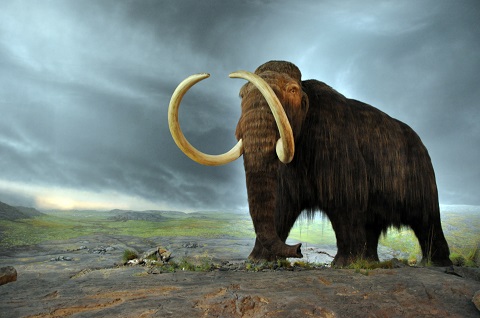The January 2017 edition of Coastlines, the UCSB alumni magazine, doesn’t display a sensational sunset view, plans for a new building or honor a Nobel laureate with a cover photo. Instead, the editors chose a drawing of a woolly mammoth with the alluring headline “Bringing Back the Woolly Mammoth”. Reading the article, we learn that the de-extinction project is led by Dr. Douglas McCauley, listed as a professor in the biology department, further identified by his picture. “I look at the machine called Life”, McCauley said. “I see gears missing and ask ‘What can we do to replace those gears?’” The accompanying text announces “A handful of scientists around the world are at the forefront of exciting and dramatic work bringing back the mammoth, the passenger pigeon and even the Dodo bird”. McCauley explained further, cheerfully admitting that his work with fellow UCSB researchers is described in some scientific circles as “boring”, certainly an unkind exaggeration. The possibility of woolly mammoths lumbering along the university bicycle paths isn’t boring at all. This is not fake news. If you’re doubtful, go to the UCSB biology faculty list to be reassured or here.
By Flying Puffin (Mammut Uploaded by FunkMonk) [CC BY-SA 2.0 (http://creativecommons.org/licenses/by-sa/2.0)], via Wikimedia Commons
De-extinction changes everything. Imagine driving north on California Route 1 and seeing your first woolly mammoth ambling across the road as you approach Big Sur. It will resemble an extremely hairy elephant with curved tusks that loop back to its eyes. Woolly mammoths are vastly different from the ordinary deer in the headlights. Our pre-historic ancestors hunted them into extinction by eating the inside and wearing the outside. Now, if all goes well, we will be able to atone for all that. Though the last ones roamed the earth 4000 years ago; their genomes lie buried in the permafrost and have only recently been discovered. The de-extinction team expects their new mammoths to be ready in a few years. They’ll be hybrids, because the genomes of mammoths will be implanted into Asian elephants to produce a what? A Mammophant? A Woollyeleph? Sadly, the scientists don’t expect this amazing creation to have a long lifespan. Enjoy them while you can.
De-extinction survival rates will improve in cases where the genomes are newer by a few millennia. The process for re-creating woolly mammoths is complex; a gargantuan in vitro experiment. For it to succeed, the team will need a young and willing Asian elephant in which to implant a woolly mammoth nucleus. Because the gestation period for those elephants is two years, we won’t know more till 2019.
The Dodo bird promises to be a better candidate. The last ones were seen towards the end of the 17th century, on the island of Mauritius. Apparently, they were quite flavorful, and were eaten by the sailors who landed there. Think what a new batch of Dodos could do for the starving African countries! Dodos can’t fly, so they practically give themselves to their predators. There’s really no downside to bringing them back. It’s all good.
The only damage will be to the cliché, Dead as a Dodo. Although Dodos thrived during the Renaissance, none of the great artists seem to have painted them. UCSB scientists have only a few Dodo sketches done by the sailors who ate them. As a result, we’ll never know exactly how to recognize the re-constituted ones. Even so, let’s take the chance. They looked like klutzy ducks with peculiar oversized beaks, and what seem to be feathers. Obviously, they’re most comfortable in warm climates; Southern California, Florida, and parts of Texas. The genesis of Dodos won’t be nearly as challenging as the woolly mammoth project. Compliant Asian elephants are hard to find, but ducks are everywhere.
Best of all will be the return of the passenger pigeon. Remember how useful they were during 19th and early 20th century wars, when they carried classified messages back and forth? Passenger pigeons were the cell phones of the past; attractive, efficient, and non-hackable. We need them de-extinctioned, and it won’t be as difficult as re-making a woolly mammoth or even a Dodo. We have trillions of ordinary pigeons to experiment upon. And passenger pigeon genomes could be readily available without arduous digging in the frozen tundras of Russia and Alaska. The last one disappeared a mere 103 years ago. For de-extinction biologists, that’s yesterday.
The only problem with de-extinction is political. Now, with an American government rolling back every bit of progressive legislation since the end of our revolution, how far will that administration go? All the way to the woolly mammoth? Before hunters and gatherers? There has to be a detour!






Be First to Comment